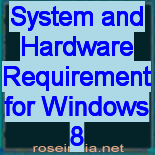Microsoft has launched its new Windows 8 in the market, but most of the users are thinking is their computer, laptop or tablet enough to run Windows 8. Here are the minimum system and hardware requirement that your computer, laptop or tablet must have to run Windows 8:
- The Processor must be 1 Gigahertz (GHz) or faster.
- It must have 1 Gigabyte (GB) RAM for 32-bit and 2 GB RAM for 64-bit.
- At least a Hard disk space of 16 GB (32-bit) and 20 GB (64-bit).
- Some games and programs might require Microsoft DirectX 10 or higher for optimal performance
- To access the Windows Store and run some apps you need a screen resolution of at least 1024 x 768.
- For snap apps, you need a screen resolution of at least 1366 x 768.
- BitLocker To Go requires a USB flash drive (Windows 8 Pro only)
- BitLocker requires either Trusted Platform Module (TPM) 1.2 or a USB flash drive (Windows 8 Pro only). If your machine does have BitLocker, it needs to be enabled from BIOS settings.
Secure boot requires UEFI v2.3.1 Errata B support and a Microsoft Windows Certification Authority in the UEFI signature database. If your machine does have UEFI, it can be enabled from BIOS settings.
Since Microsoft has removed the barrier between different devices and made one window for all computer, laptop and tablet, it has made Windows 8 touch supportive. Now to use touch, the monitor or tablet must support multi-touch. Windows 8 is accessible with mouse and keyboard as well.
